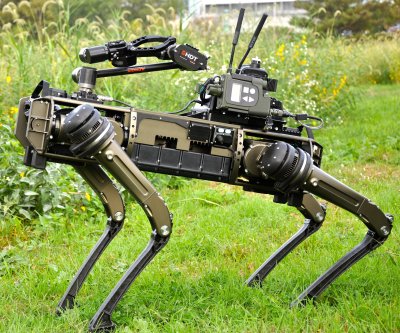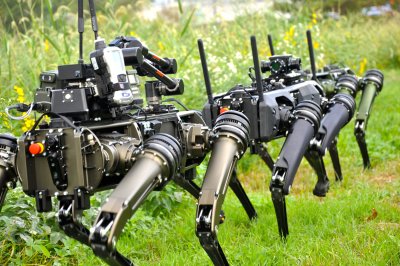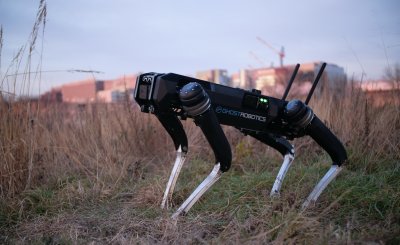I was always interested in technology and machines, but growing up I also thought about becoming a veterinarian. I actually had an uncle who was a veterinarian, so I shadowed him when I was a teenager in Ireland.
Then my interests really coalesced. I was heavily involved in robotics competitions in my formative years and then later on in high school in Canada, I watched a TED talk by Professor Bob Full who works in integrative biology at University of California, Berkeley. Professor Full does a lot of biomechanics research into how the ablest of animals are able to move around in incredible ways in the natural world.
I ended up calling him during my undergraduate studies in mechanical engineering. He said that he appreciated my enthusiasm, but that if I wanted to do this kind of work on the engineering side I should be contacting his collaborators, the engineering professors. I misspelled every name he told me over the phone, but the first name was Daniel Koditschek, who ended up being my PhD advisor at the University of Pennsylvania. My work there, starting in 2012, was in understanding how animals achieve their amazing mobility, and then trying to synthesize those principles into robotics.
The birth of our robot dogs
When I was in my PhD program, I was working quite closely with my colleague, Avik De, on the robots that were in the lab there. The status quo robots at the time were actually bio-inspired by cockroaches. The muscle firing pattern for a cockroach, it turns out, is actually identical when they’re walking over really rough terrain and when they’re walking over completely flat ground. They have a very carefully fine tuned mechanical structure in their legs.
These robots were very good at going over rough terrain, but they weren’t really very responsive in terms of interacting with the environment. So myself and Avik saw room for improvement and ended up building our own infrastructure with four legs that were maximally reactive to the environment. We actually built three robots, using these infrastructures and principles, and our four-legged Minitaur robot was the easiest to control.
Originally, it was really just about research. There were no customers in mind, and we were actually selling the robots to other researchers. We had seen what other companies were doing, in terms of trying to make legged robots useful in real world settings, and robotics was obviously hugely successful in very controlled environments already.
In a factory setting you have robot arms building cars, welding or painting, but it’s such a controlled environment. If there’s any unexpected contact between a robot arm and something else, it might cause the whole plant to shut down and a full investigation to take place. In the real world, every time the leg of a robot touches the ground, that’s technically an unexpected collision. You need a robot to be able to deal with that, and have the system be robust.
After a couple of months, our CEO, Jiren Parikh found us in 2015 and together we strategized for quite a while. We didn’t have any money; we were just bootstrapping, based on the sales of the Minitaur robots and credit cards.
But we wanted to build a four-legged robot that was sealed, fully ruggedized and field repairable, with good endurance and battery life. And, we wanted it to have the capability to carry around payloads in a real world setting.
So, we started to build our Vision 60 Quadrupedal Unmanned Ground Vehicles (Q-UGVs); a new robot. Very early on, we would have rough prototypes of robots and would tell customers that if they helped us to fund this, they could help us sculpt the product into exactly the type of robot they thought would be useful. One of our first customers was United States Naval Special Warfare Command, who work in collaboration with the Navy SEAL teams. At that point it was really just about ISR (intelligence, surveillance and reconnaissance); being able to keep people a little bit further back and sending the robot out first into dangerous situations to get some situational awareness there.
What can a robot dog do?
Calling the Vision 60 a “dog” robot is pretty accurate. A lot of our customers refer to our robots now as “the dog.” What differentiates our technology is that our robots have the ability to feel the environment and terrain through the motors themselves. Typically, the way robotic arms and legged robots are built is with a very small motor, and then a very large gear ratio. Our robot dog’s motors are just inherently more robust and back drivable because of the much smaller gear ratio. This also lets the motors “feel” the ground without the need for any additional sensors, enabling the robots to traverse difficult terrain including sand, snow, ice, mud, and rocky slopes.
Our robot dogs weigh around 100lb and can last for three hours continuously walking at a pace of one meter per second. But that can be extended if there is standing or inspection time as well as walking. When the battery gets low, it returns back to what we call its “dog house” and sits on a wireless charging dock to charge while another robot dog deploys.
There are really only two types of broad applications for the robot dogs. The first type is more ad hoc, where the robot is sent out ahead of people for inspection, or determining if there is an explosive device or some kind of dangerous chemical or nuclear agent present. Sending the robot out equipped with the right sensors means it can investigate what’s going on; whether it’s with a regular visual camera, a thermal camera, or any number of more exotic sensors, the robot is getting more situational awareness. Similarly, if something is suspected of being an improvised explosive, you could have a human dress up in a bomb suit and investigate, but if something goes wrong, it’s really harmful. Or, you could just send a robot dog up ahead to do the same thing, perhaps with a disrupter, which is an attachment for the robot that is able to destroy those improvised explosives without setting them off. We have partnered with Zero Point to do demonstrations with their disruptor for bomb squads across the U.S. and with ARES Security Corporation to show how robots can help with nuclear power plant decommissioning at the Hanford Site in Benton, Washington.

Ghost Robotics

Ghost Robotics
The second type are persistent behaviors. That could be in an industrial context for an inspection patrol. In a manufacturing plant, say, the robot dog may go out a few times a day, walk the same route and take a look at reading some gauges, or look at the temperature of equipment to make sure that everything is operating within spec. In a military or government context, the robot can do the same thing, but it’s in more of a security setting. At Tyndall Air Force Base in Florida right now, the robot dog patrols a couple of times a day, walking a five mile route in a very harsh swamp-like environment, recording camera feed and just looking for anomalies. ID checking by our robot dog isn’t an application that’s in use anywhere yet, but we are hoping it will be in the future.

Ghost Robotics

Ghost Robotics
Robot dogs patrolling the U.S. border
The U.S. Department of Defense (DoD) funds a lot of research in robotics, so the military interest in our robots is certainly nothing that was too much of a surprise to us. Tools like GPS, or the internet, really started with a huge amount of government funding to help the products reach the level of refinement and sophistication that were then useful in the private sector.
U.S. Customs and Border Protection (CBP) have shared that our robot dogs have been on training exercises in order to be used to patrol the southern U.S. border. It’s very difficult terrain and it’s also a large area that needs assets with cameras to be able to have a good understanding of what’s going on, or chemical sensors to look for drug interdiction. There’s so much going on from a security standpoint, and there’s so much complicated terrain to traverse that it seems like it’s really just a natural fit for something like a legged robot dog.
The robot dog knows it’s going from point “A” to point “B”, and if there’s an obstacle in the way it steps around the obstacle. So if it did interact with a living being, it would just try to go around it. But it is mostly used in environments where there aren’t lots of people. And that’s exactly the point. In these very sparse environments where there are few people, or it would be too dangerous for people to be in those settings, there is a need for information from the environment.
Are robot dogs safe?
I think that a big misconception people have is that because we see robots in movies and TV shows that are clearly making all their own decisions, when we then see a robot in the real world, we think it could be making a high level decision. It is absolutely not doing that.
We go above and beyond in terms of making sure that the robots themselves are safe. They’re being controlled by a person. The highest level of coordination for our robots, at this point in time, is that a person looking at a big screen will have multiple robots on the map, and they can have the robots move around strategically.
The robot dog is not making any decisions on its own, it’s just amplifying the ability of one person to have all these distributed eyes or sensors move through the environment.
The reason our robot dogs are not going to run free is because there’s no agency for them to do anything like that. It’s similar to a smartphone in terms of how it knows where it is in the environment. Like a smartphone, it has GPS and other sensors. But will your phone ever decide that it wants to go somewhere of its own volition? No.
If the robot dog is told to go to certain GPS waypoints, until further instruction, and it doesn’t get any other instructions, it’s just going to keep going on the same waypoints until at some stage, the battery will die, or it’ll sit down because the battery is low. There are also emergency stop buttons that can cut power.
Weaponizing the robot dogs is something that we’re not doing ourselves, the robot is really a platform. And so from our perspective, that’s really a decision that the government is making. They’ve funded the research and development and they’re buying these robot dogs, and I think that choice falls within the purview of what they want to do with these platforms. There are all kinds of military laws of ethics and many processes going on in the background, and we feel these are the right people to be able to make these kinds of decisions. And, the robot is not an autonomous system that is making any life or death, any critical decisions, on their own. There’s a person at the other end making all these decisions. The robot is really a tool.
The future of robotics and robot dogs
We now have around 30 people on the team at Ghost Robotics, but I am still very much involved with the design of the robots themselves. We continually make improvements and in the near future, we’ll be building the Vision robots at different scales. We already have a smaller robot, for researchers only, that weighs about 25 pounds. A ruggedized version of that smaller robot would be cheaper and could be more widely adopted for industrial inspection, especially ducts or other confined spaces that are dangerous and difficult for people to traverse.
This technology is very applicable to all kinds of other systems that require force-controlled interactions with the environment; having motors that are back drivable and responsive, but that are still quite strong. Personally, I think it’d be very interesting in the longer term to get into prosthetics or exosuits.
I was always interested in startups. My grandfather is very entrepreneurial, so I think I got a little bit of that from him. And my parents are both academics, so I got a little bit of that side from them. Merging those two worlds has been extremely fulfilling on a personal level.
It’s just so unusual that you’re able to do work in a field that’s close to your PhD. This is the kind of work that I’ve been doing for the past decade, and I just get to keep doing it. I thought that after I graduated perhaps I would join a startup. I thought the roller coaster of a startup was exciting, but I never really imagined when I started my PhD that I would be a co-founder of one that is now going through all this growth. We have had ups and downs, but it’s been very, very fulfilling.
Gavin Kenneally is co-founder and chief operating officer of Ghost Robotics, based in Philadelphia. You can find out more at ghostrobotics.io or follow on Twitter at @Ghost_Robotics.
All views expressed in this article are the author’s own.
As told to Jenny Haward.
Credit: Source link




















